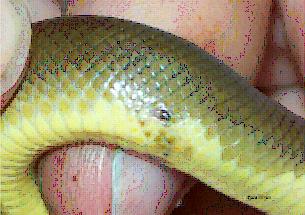t has never occurred to me to speak with elegant animals. I am not curious about the opinion of wasps or of racing mares. Let them settle matters while flying, let them win decorations by running! I want to speak with flies, with the bitch that has recently littered, and to converse with snakes…….I want to speak with many things and I will not leave this planet without knowing what I came to seek, without investigating this matter, and people do not suffice for me. I have to go much further and I have to go much closer. —-Pablo Neruda, Bestiary

If you are afraid of snakes, then this is the snake for you. While some snakes are just known to be downright nasty – well, ok, very defensive – the rubber boa is the sweetheart of snakes. It will never bite. Never. Snakes also “musk” when they get nervous/excited and will excrete a smelly fluid – and rubber boas also seem very reluctant to employ this tactic. If you pick them up slowly and carefully they don’t seem to mind.
It’s the PNW’s only boa species – these snakes kill by constriction, wrapping up their prey and slowly squeezing them until they can’t take a breath, then swallowing them whole. It’s rough out there. Charina is from the Greek for graceful or delightful (!!) and the species name of bottae honors D. Paolo E. Botta a ship doctor, explorer, and naturalist on the ship Le Heros (1826 – 1829).
Rubber boas get their name from their shiny skin – they have smooth scales as opposed to keeled scales – and it’s sometimes wrinkly, rubbery, appearance. They are quite the handsome snake – with colors that range from tan/dark brown to an olive green, yellowish, or orange. They have tiny eyes with elliptical pupils and a blunt nose. They range over much of the western U.S. from the coast to western Utah and Montana and south to around San Bernardino and north to southern B.C.


Rubber boas are ovoviviparous and give live birth to up to nine young a year. So reptiles can be viviparous (live young), oviparous (lay eggs), or ovoviviparous – which, without getting too complicated – means that the embryos mature inside eggs inside the female and then are born live. Rubber boas mostly eat a variety of small mammals including shrews, mice, and voles, but are reported to eat young birds and bats, and other snakes.
While they range on both sides of the Cascades I’ve only seen them on the east side – near Rosyln, in the Teanaway Valley, and down the the high lava province of eastern Oregon near Bend. Colin McCall in Seattle was kind enough to offer these photographs he took in North Cascades National Park, just over the crest on the east side of the Cascades.
You can easily determine the sex of a rubber boa – the males have a spur on their sides which is a remnant of the hind limbs, while females have smaller spurs that exhibit a minor indentation on the skin. The male uses these spurs to stroke the female during mating. They spend most of their time under debris and are crepuscular (dawn/dusk) and nocturnal. I’ve never found one just crawling around – I’ve always found them by turning over logs, pieces of plywood, or other debris.
Their defense is to curl into a ball with their head in the center, and they can shake their tail as if to imitate that it is really their head. No wonder they spend a lot of time under cover, as this is not likely to generate a favorable outcome when predators are encountered.
So – first rule of looking for snakes – never put your hand somewhere that an unknown snake could be dwelling.
The second rule is – don’t pick up a snake that you can’t positively identify (or at least rule out it’s not poisonous). But, if you are sure it’s a rubber boa and you are calm and careful – you will come away with an enchanting encounter. The forecast is for a sunny weekend – so happy serpent hunting.
